The Corsair STRAFE Mechanical Keyboard Review
by E. Fylladitakis on July 15, 2015 8:30 AM EST- Posted in
- Keyboard
- Peripherals
- Corsair
- Mechanical Keyboards
The Corsair STRAFE Mechanical Gaming Keyboard
Externally, the STRAFE is a completely different design than any of the RGB family keyboards that we reviewed in the past. Although the design remains modern and is rather elegant, the flat metallic body is now gone, as the STRAFE has a low profile plastic frame without a wrist rest or support for one. The keys are installed on a red support plate for increased visual contrast and mechanical strength. It is noteworthy to mention that the controversial "winged heart" logo that debuted alongside with Corsair's Gaming division and received much negative criticism is now gone. Corsair's new gaming peripherals logo, a variation on the previous ship sails logo, is now relocated to the top left side of the keyboard.
Although the aluminum body is now gone, the plastics that Corsair is using are of good quality, with great rigidity and feel. The top cover is slightly textured but the sides of the keyboard are glossy and slightly reflective. LED lighting strips have been installed on both sides of the keyboard in the gap between the glossy sides and the textured top cover.
The STRAFE pretty much is a standard full-size keyboard, with the only two extra keys being the square keys at the top right side of the keyboard. By default, one of the square keys controls the intensity of the lighting, while the second locks the Windows keys so they are not accidentally pressed during gaming (which minimised the game and causes a bit of rage). Media functions for volume and track controls have been inserted as secondary commands in the F5-F12 keys, and are accessible by holding down the FN key. There are no dedicated media keys or the much-loved metallic volume control wheel that is found on their higher tier keyboards. Since the STRAFE is fully programmable, it is highly likely that one of the two extra keys can become a volume mute key, or both are going to become volume control keys. There is a lot of dead space between the Numpad and the two keys at the top right side of the keyboard, so there may be an upgraded version in the future with at least the basic volume control keys there.
The stock keycaps of the STRAFE are standard black keycaps with enlarged characters, with the exception of the Space Bar key. The Space Bar key is textured and it feels great while typing. The surface of the Space Bar should also decay less easily now, as Space Bar keys with their right side heavily worn out are a common phenomenon. Beneath the keycaps, Cherry MX switches with red LEDs are used. We received the version with the Cherry MX Red switches, but Corsair also offers the STRAFE with Cherry MX Brown switches. The selection of a switch is heavily a matter of personal preference. Some people like the soft tactile feedback of the Brown switch while others enjoy the linearity and responsiveness of the Red switch.
Corsair supplies two sets of contoured and textured keycaps alongside with the STRAFE. The WASD keycap set is meant for FPS gamers, while the QWERDF set is meant for MOBA gamers. If someone likes to change the stock key settings from, for example, WASD to ESDF like some FPS gamers do, the only solution would be to use the contoured keycaps in the place of the ESDF keys, ignoring the wrong characters.
The STRAFE actually features one thing that none of the top tier Corsair keyboards has - an USB port. The pass-through USB port is found at the rear of the keyboard, near the thick cable. It is worth noting that there is no polling rate switch on the STRAFE, and the cable is not braided either - it is a thick black cable with futuristic easy-grip connectors.




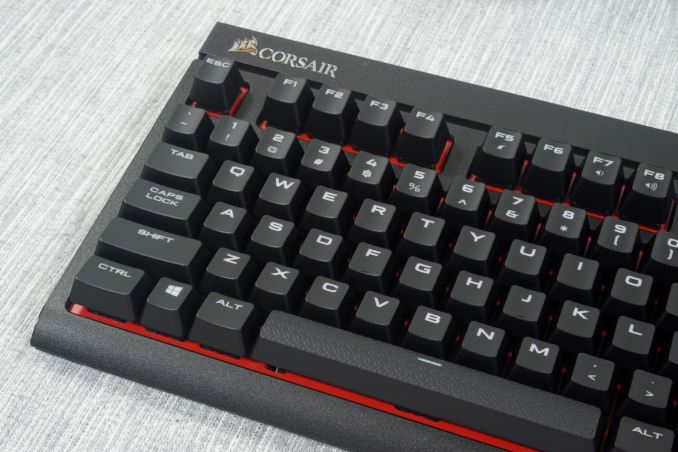
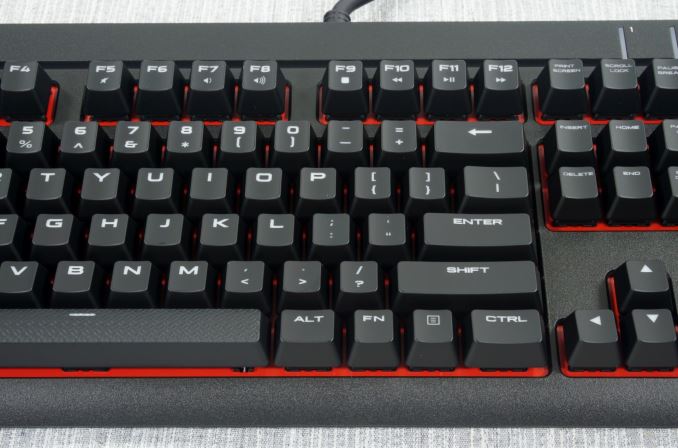
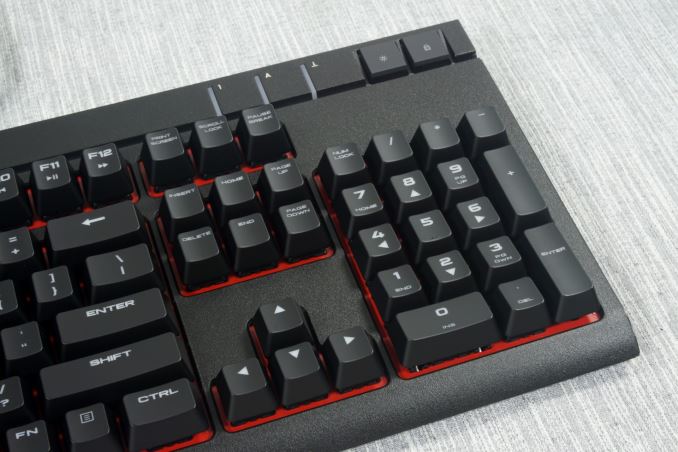

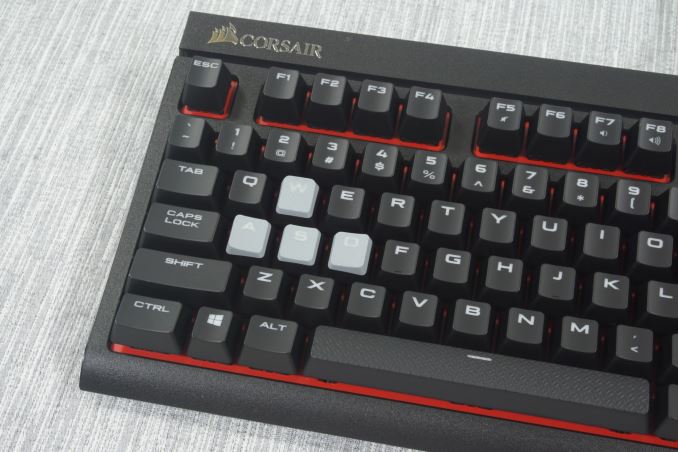
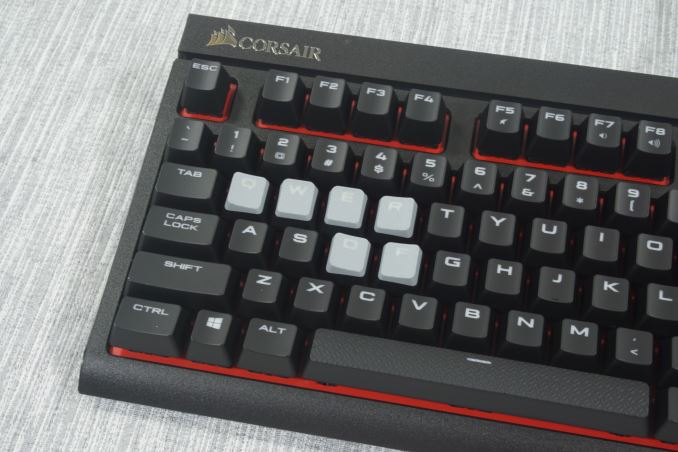
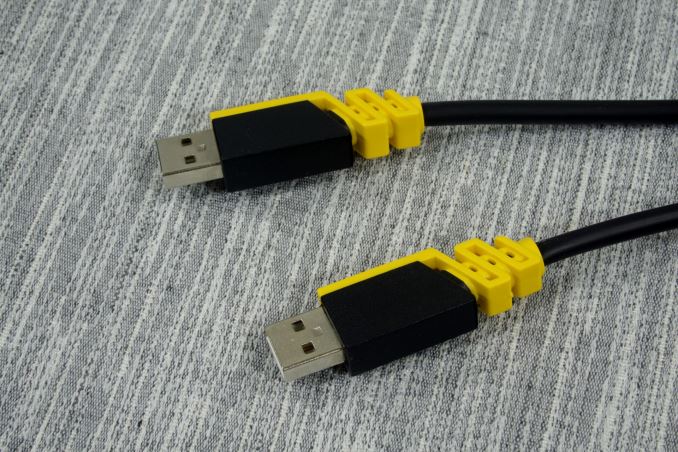
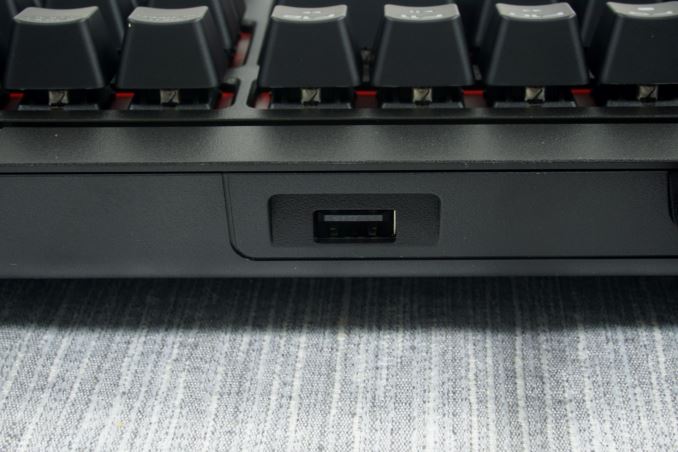








53 Comments
View All Comments
gamemavin - Wednesday, July 15, 2015 - link
"The STRAFE actually features one thing that none of the top tier Corsair keyboards has - an USB port. The pass-through USB port is found at the rear of the keyboard, near the thick cable."My Cherry MX Red K70 has a USB port in the same spot - at the rear of the keyboard to the right of the thick cable...
E.Fyll - Wednesday, July 15, 2015 - link
Key words here are "top tier". The standard K70 is a very well made keyboard but it is not even programmable. The K70 RGB falls into the "top tier" classification.Coup27 - Wednesday, July 15, 2015 - link
I am not sure I entirely agree with the definition of "top tier" meaning it is simply programmable. I could not care less if my keyboard was programmable I would rather it be well made, look nice and feel nice to type on. If it met all of this I would still consider it top tier, just meeting a different set of criteria.Either way, I actually do own a K70 and while I do really like it I think the aluminium top plate is a bit of a case of style over substance. Yes it looks lovely, but press down on it anywhere on the keyboard and the plastic chassis will creak quite badly. There is no creaking during typing, but that's not really the point. Surely Corsair could have made the whole chassis frame out of aluminium and then we would have a keyboard!
Flunk - Thursday, July 16, 2015 - link
Programmable keys are pretty pointless, it's mostly a software feature that can be replicated easily using 3rd party software.Impulses - Saturday, July 18, 2015 - link
Well, the programming can be saved to the keyboard no? Some will value that... Because they use it on multiple machines, or don't like the software running, or whatever.ntuxn00 - Saturday, July 18, 2015 - link
So, you're telling me that a gimmick is what decides what's top tier and what's not?ntuxn00 - Saturday, July 18, 2015 - link
In no way, shape, or form is it being programmable necessary for a keyboard to be of high quality and revered as top-tier. What you're telling me is that the Scuf controller is top tier.. That a programmable macro is top-tier.. NODorek - Wednesday, July 29, 2015 - link
That's a ludicrously stupid criteria.Eidigean - Wednesday, July 15, 2015 - link
"an USB port" - Sorry, I can't resist. Anyone else having trouble saying this phrase? Yes the general rule is use "an" when the next word begins with a vowel, like "an apple". But we're not saying "an OOH-ESS-BEE port" we're saying "a YOU-ESS-BEE port" so use "a" not "an". Thanks! </soapbox>Coup27 - Wednesday, July 15, 2015 - link
Whether to use a or an before a vowel is determined by the pronunciation and not by the spelling, as many people wrongly assume.People should also use "an SSD" instead of "a SSD".